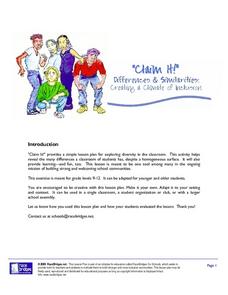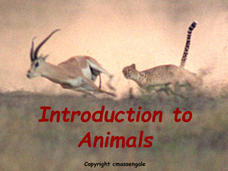Curated OER
Reptiles and Amphibians
Introduce your class to various reptiles and amphibians. They will meet and identify a representative from each of the four major reptile families, then learn about and discuss reptile characteristics. Next, they will identify and...
Balanced Assessment
Modern Building
Turn your pupils into emerging architects with a resource that asks learners to analyze a scale drawing of a building. They use the scale drawing to interpret the size of the actual building before recreating the drawing using a...
English Worksheets Land
Compare and Contrast
Even though two passages discuss the same topic, they contain different facts and details. Scholars analyze two reading passages about the Gettysburg Address and list the ways they are the same and different.
Curated OER
Library Lesson Plan
Explain the differences between fiction and non-fiction and the characteristics of a biography. Learners analyze three pieces of literature on the same topic to determine which is fiction and which is non-fiction. In the end, relate the...
English Worksheets Land
Compare and Contrast - Popcorn
Discover why popcorn pops and how it found its way to the movie theatre with a worksheet that reinforces comparing and contrasting skills. Scholars read two brief passages then share through writing the similarities and differences they...
Curated OER
Claim It: Differences and Similarities, Creating a Climate of Inclusion
Students explore the concept of diversity. In this inclusion lesson, students discuss similarities and differences among students in their class, identify the benefits of diversity, and write personal commitment statements regarding...
Curated OER
Which one is Different?
In this alike and different worksheet, students view and study 9 pictures of Dr. Seuss. Students determine which one is different from the others. Students draw a circle around the one that is different.
Curated OER
Identifying What is Different
What is the same, what is different, and what does it all mean? Introduce the concept of identifying similarities and difference to your Kinder class using the I do, we do, you do, instructional approach. You'll provide structured...
Curated OER
My Family and Me: Our Similarities and Differences
Students are introduced to basic genetic information to discover how they acquired the traits they have. Individually, they develop a family tree and identify the similarities and differences between two poeple. In groups, they examine...
Curated OER
U.S. and Canada: How are We the Same? How are We Different?
Get high school geographers to compare and contrast Canada and the United States. They begin by drawing a freehand map of North America, then complete readings to gain insight into Canada. The text is not provided; however, another text...
Core Knowledge Foundation
Different Lands, Similar Stories Tell It Again!™ Read-Aloud Anthology
A read-aloud anthology highlights how one story differs depending on where it comes from. Scholars listen carefully to familiar and new stories, participate in discussions, and complete word work practice. Extensions for each lesson...
Curated OER
Communism and Fascism- What are the Similarities and Differences
In this world history worksheet, students complete a table comparing Communism to Fascism. They determine the similarities and differences, and how the two ideals got their beginnings. They compare the two influenced landowners,...
Curated OER
The Similarities and Differences of Setting
Sixth graders compare science fiction to reality. For this setting lesson students use Chapter 6 of A Wrinkle in Time by Madeleine L'Engle. Students record detailed descriptions from the text that are different of similar to real life.
Curated OER
Form and Observation
Use a familiar song and adorable baby animal pictures to teach youngsters about genetic variation. Begin by listening to "Twelve Variations on 'Ah vous dirai-je Maman,'" which you will need to find online (there are several versions...
Council for Economic Education
Banks and Credit Unions (Part 1)
Imagine you have money you want to save ... where do you put it? Pupils investigate the similarities and differences of banks and credit unions as they determine where exactly to place their hard-earned money. Through a WebQuest,...
Everyday Mathematics
Mathematics Within: Slope and Triangles
Learners discover a method for determining the slope of a line by creating and comparing similar triangles. They fold coordinate grids to make three similar triangles then measure the sides to compare the relationships between the...
NASA
Whip Up a Moon-Like Crater
The moon is famous for its craters, but they haven't always been there. Young learners experiment with materials to simulate the creation of moon craters. Pupils are able to see patterns in their materials that are similar to the...
University of Colorado
Looking Inside Planets
Researchers use scientific data to understand what is inside each of the planets. The first in a series of six, this lesson builds off of that concept by having pupils use a data table to create their own scale models of the interiors of...
Biology Junction
Introduction to Animals
Out of all animals, elephants alone lack the ability to jump. Scholars learn all about animals using a presentation full of fun examples. It describes different types of animals, the biological similarities and differences between...
National Science Teachers Association
Hop into Action
Young scientists find out what makes amphibians such unique and interesting animals in this simple life science lesson. After looking at pictures and discussing the characteristics of amphibians, learners complete a series...
Rainforest Alliance
Get in Touch with Nature
Take a trip to the Colombian rainforest through the sense of touch. Here, class members discover what's inside a mystery box: wood, cinnamon, Brazil nuts, a banana, and orange. Then, the class takes a trip outside for a tree rubbing...
PBS
Why Do We Have Seasons?
Explore the reason for the seasons! An interactive lesson allows learners to explore the earth's rotation from the viewpoint of four cities at different latitudes. It provides descriptive information at eight points during the orbit...
Curated OER
Similar and Different
Fourth graders observe a pair of students standing in front of the class and compare and contrast them using a Venn Diagram using these guidelines: eye color, hair color, older/younger, tallest/shortest, gender, favorite food, favorite...
Curated OER
The Flow of Women's Work: How Cultures are Alike and Different?
Learners examine gender roles in various cultures. In this flow of women's work lesson, students compare water related work in rural Africa to that in their own households.























